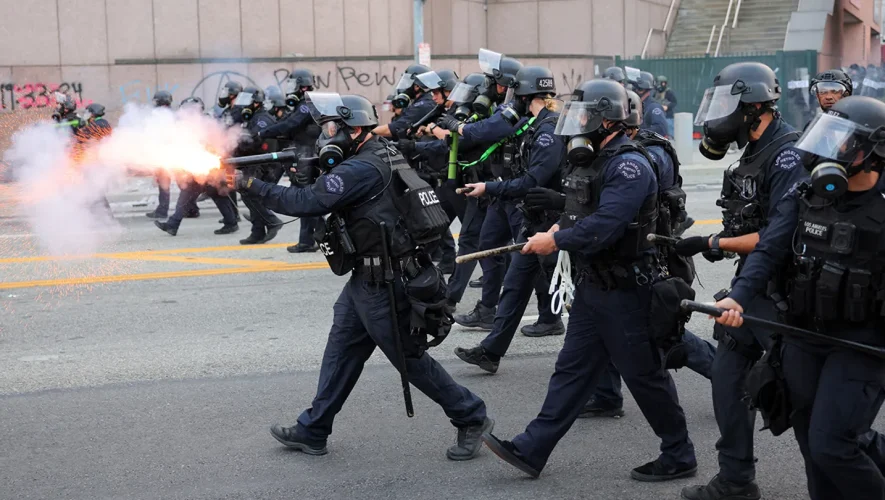In 2020, police departments across the US deployed widespread militarized response in light of the nation-wide Black Lives Matter protests. Policing in the US has become increasingly militarized, with the War on Drugs serving as a major catalyst. The War on Drugs, a government-led initiative to fight illegal drug distribution and use, led to policy changes that in turn facilitated the transfer of military equipment to police departments at the click of a button. As police deploy military tactics and equipment, the traditional separation between civilian law enforcement and military disappears, fundamentally changing the relationship between police and communities. Further, racial bias in policing is fundamental. Racialized social control has been a central function of law enforcement, making the issue of police militarization even more pressing. Behind these domestic developments is a foundation rooted in international conflicts, with military veterans using their experience serving in imperial territories to shape domestic law enforcement reforms.
The development of policing has a complex and lengthy historical background that is based on a foundation of British policing. In 1829, Sir Robert Peel created the first police force in London, inspired by his work managing the British colonial occupation of Ireland, where he sought new forms of social control due to riots, insurrections, and political uprisings. These issues were previously managed by the military, however, the Metropolitan Police Act of 1829 established an independent civilian force to protect property, quell riots, put down strikes, and exercise other forms of social control. This model of policing was implemented in the US as the industrial revolution demanded a mechanism to manage the widespread social disorder and riots associated with the working class.
Police militarization evolves from domestic policing—facilitated by the adoption of military tactics and acquisition of military equipment and technology—to act and appear like a paramilitary force in the streets of the United States. In the early 20th century, police departments took inspiration from the “Root reforms” that organized the US army to fight the Philippine-American War. These military reforms amounted to a new imperial-military regime oriented towards counterinsurgency and colonial conquest.
The army’s success emboldened the “Police Professionalization Movement,” which was pioneered by military veterans who served in the regime—notably August Vollmer, the father of modern American policing. Vollmer served in the Philippines during the Spanish-American War, later returning to the US to use his knowledge to change the face of American policing. His reforms shifted the mindset of law enforcement officers to view metropolitan areas with large minority populations as analogous to colonial territories. Imperial spaces are racially hierarchical, with colonizers monopolizing power by perpetuating racial ideologies that depict the colonized as uncivilized, incapable of self-government, or prone to criminality and disorder. Bringing this counterinsurgency mindset home means urban areas with large minority populations are viewed in the same light as colonies, with communities labelled “inferior” threats to the social order. The same tactics used against insurgents—systematic surveillance, rapid deployment of mobile forces, and swift suppression of potential unrest—were transported to domestic settings through innovations like radio patrol cars, mounted mobile units, the Bertillon system of identification, and fingerprinting. These methods completely transformed early civilian-local policing, creating a framework where civil rights protests and other demonstrations were viewed as equivalent to coups and guerrilla warfare.
The counterinsurgency framework established by veterans like Vollmer would prove enduring, resurfacing with renewed intensity during later national crises. Declaring a national war on drugs was an attempt to win back the hearts of the American people by redirecting national focus toward a domestic enemy, as public support for the Vietnam War declined and Cold War fears of communism waned. The backbone of the War on Drugs was the implementation of harsh enforcement tactics, consisting of massive incarcerations and seizures, which led to the widespread abuse of force. Building on the militaristic foundation laid by veterans like Vollmer, the War on Drugs intensified police militarization through aggressive tactics such as no-knock warrants, rigorous raids and seizures, and riot-suppression techniques. These methods marked a dramatic departure from traditional policing, which had emphasized visible patrol, crime response after the fact, and maintaining order through community presence rather than preemptive force.
Special Weapons and Tactics teams are largely associated with the War on Drugs. The idea for SWAT teams was popularized by Vietnam War veteran John Nelson in the 1960s, who took inspiration from his force recon unit in the marines. The men selected were trained by military personnel to teach the team in counterinsurgency and guerilla warfare tactics, exemplifying the cultural acceptance and adoption of increasingly militarized policing. From the 1980s through today, SWAT teams have been the frontline fighters in the drug war, utilizing armored vehicles and assault rifles to execute highly controversial no-knock raids that have staggering human costs. According to the Police Brutality Center, “studies have shown that no-knock warrants substantially heighten the risk of police violence and are prone to brutality, misconduct, and discrimination,” a truth that is difficult to swallow considering there are around 20,000 no-knock raids conducted every year.
To supply SWAT teams and police departments in fighting the War on Drugs, Congress authorized Program 1033, which allows for the transfer of excess military equipment to state and local law enforcement. This was a major escalation in militarized policing because police departments now had easy access to armored vehicles, surveillance equipment, grenade launchers, aircrafts, assault rifles—essentially any piece of military equipment. The main rationale for this program was centered around the War on Drugs, particularly heroin use by the US army during the Vietnam War. The idea that heroin abuse was compromising the efficacy of soldiers and impacting the war effort in Vietnam shifted the issue of drugs from a domestic problem to a national emergency requiring a militarized response.
Ultimately, the militarization of policing in the United States has transformed the relationship between law enforcement and the communities they serve as police departments increasingly resemble a paramilitary force shaped by imperialism. The integration of military training, tactics, and equipment—fueled by the War on Drugs and Program 1033—intersects with cultural shifts as police officers adopt the counterinsurgency mentality, which can mean life or death for those on the other end of the gun.
The threat of police militarization is omnipresent with a second Trump administration. Trump has been a long supporter of “tough on crime” policies which largely encourage brutal policing practices, pursuing extreme sentences, and expanding the use of the death penalty. On April 28th, Trump issued an executive order titled “Strengthening and Unleashing America’s Law Enforcement to Pursue Criminals and Protect Innocent Citizens” that works to protect police officers from accountability when they abuse their power or break the law. Per the ACLU, these policies call for further protections for abusive police, including “condoning the use of force against protesters, which he once described as a ‘beautiful thing to watch.’”
This sentiment is extremely troubling given the recent protests in Los Angeles against immigration enforcement operations. Federal agents deployed military-grade weaponry typically reserved for combat zones, lobbing flash-bang grenades and dispersing pepper spray and tear gas at protesters in downtown Los Angeles as tensions over immigration raids heightened. The heavy handed response transformed downtown Los Angeles into what resembled a war zone, violating the foundational democratic principle enshrined in the Posse Comitatus Act, prohibiting military policing of civilians. Trump’s federalization of the National Guard compounds this violation by directly mobilizing military forces against American citizens exercising their constitutional rights.
Understanding the imperial origins of police militarization reveals a disturbing truth: what we are witnessing today is not an anomaly but the culmination of more than a century of institutional development. The same counterinsurgency mindset that Vollmer imported from the Philippines now governs how federal agents respond to immigration protests in Los Angeles. The same tactics designed to suppress colonial rebellion are deployed against American citizens exercising their constitutional rights. When police departments treat American protesters like enemy combatants, democracy itself becomes the casualty—revealing that the militarization of policing has evolved civilian law enforcement into an occupying army waging war on its own people. The badge and the uniform may suggest civilian authority, but the armored vehicles, combat weapons, and counterinsurgency mindset reveal the truth: American communities are not being protected and served, they are being pacified and controlled.



